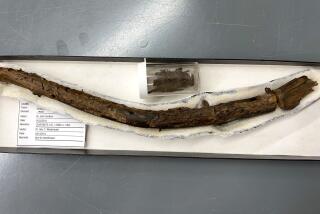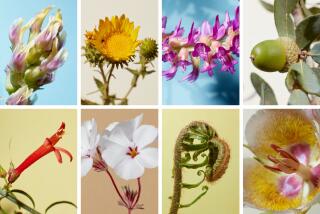Plant life worth rediscovering
GOLDENDALE, Wash. — As they journeyed West in their search for a passage to the Pacific Ocean, Meriwether Lewis and William Clark were struck by sturdy yellow flowers with large, arrow-shaped leaves near the Columbia River.
The arrowleaf balsamroot, a regular source of food and medicine for American Indian tribes, was one of 176 plant specimens collected and documented by the explorers’ Corps of Discovery nearly 200 years ago.
The flower inspired Indian artists, who re-created the sunflowerlike image on leather beaded bags. Decades later, contemporary artists photographed and painted delicate watercolors featuring the plant.
Now, the Maryhill Museum of Art celebrates the passions inspired by native plants with an exhibit that includes study specimens from the Corps of Discovery, early 20th century photographs, American Indian basketry and beadwork and contemporary works of art.
“The plants are the focus. They endure, and all these people have seen different things about them,” said Lynette Miller, guest curator for the exhibit from the Washington State Historical Society.
Lee Musgrave, special projects officer for the museum, agreed.
“You have Native American objects from the times of Lewis and Clark, then you have the Lewis and Clark specimens. Then, more than 100 years later, you have contemporary works of art,” he said. “To see it interpreted by such a variety of people in such different ways, that’s what enriches our lives. It’s wonderful to have something that almost anyone will find appealing to them.”
The exhibit, running through Nov. 15, centers on 12 to 15 plants documenting what Lewis and Clark saw, how American Indians viewed and used the plants and what inspiration contemporary artists have drawn from them.
Photographs of the original herbarium sheets created by Lewis and Clark join early 20th century, hand-tinted photographs by Northwest photographer Albert Barnes.
The images of cattails, wild roses, bluebells, lilies and other plants adorn beaded bags, gloves and leggings created by American Indian artists in the late 1800s and early 1900s. Coiled baskets woven from beargrass and cedar root add dimension to the exhibit.
What is more important, they stress what American Indians have known for centuries: These plants add significance to our lives.
“Time changes everything. Fifty years, 100 years, 200 years ago, these plants were everywhere,” said Ella Jean Jim, a member of the Klamath band of Indians from the Yakama Nation. “What was is not what is now, but it can be revived. It can be brought back. It can come alive again.”
The contemporary artists too had a deep desire to see the environment preserved -- a trait they all had in common, Musgrave said.
And finding the artwork was easy.
“When we started this project and determined we wanted to include contemporary artists, I thought we’d have a difficult time finding artists who focused on plants related to Lewis and Clark. Then we started looking and found them all over the place,” he said.
They include delicate watercolors by Rebecca Allan and bold photographs by Ineke de Lange and Ron van Dongen.
Kay French drew inspiration from the original herbarium sheets created by Lewis and Clark to document their botanical finds. Her romantic acrylic paintings on wood include numbers and figures alongside the plants, flowers and bugs.
“It was quite a feat, what they collected,” she said. “I deal with plants that would be found in an imaginary paradise -- bighead clovers, chickweed, desert parsley. When I work, I often alter them, but in this situation I tried to be more reasonably accurate and faithful to the plant. That was a challenge to me.”
Some of the artists researched Lewis and Clark’s botanical contributions before creating their work.
Stephan Soihl created watercolors and mixed-media prints that feature the love for the wilderness he shares with the Corps of Discovery.
“It was 200 years ago and things were very wild out here,” he said. “It’s kind of wonderful because it’s what I’ve loved for many years, and to have a chance to put what I would enjoy doing anyway to good use as part of the Lewis and Clark commemoration, it’s been wonderful to me.”
More to Read
Sign up for The Wild
We’ll help you find the best places to hike, bike and run, as well as the perfect silent spots for meditation and yoga.
You may occasionally receive promotional content from the Los Angeles Times.






